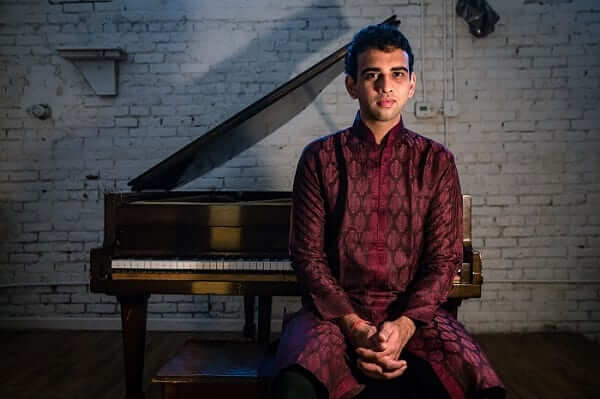Musician Utsav Lal knows that many facets of Indian classical music are almost physically impossible to bring alive on the piano.

“Yet, the joy is in finding ways to create the illusion of meend, and maybe re-tune a few notes on the instrument to get the super beautiful peaceful Gandhar of Raga Yaman,” says the 28-year-old New York based pianist.
AT A GLANCE
- Pianist Utsav Lal, 28, began his career in western classical music
- Hindi film songs drew him to Hindustani classical music
- After training in the Dhrupad tradition, he began playing ragas on the piano.
- He is the first musician to have recorded an entire album on the new invention called Fluid Piano
READ ALSO: Remembering Pandit Jasraj: the last aalap
Utsav Lal’s work on the piano has been deeply influenced by Dhrupad and Indian classical music, putting in the rigour to do the impossible on the piano makes him push the instrument in a very different direction to the way other pianists have chosen to.
With six albums to his credit, the young musicians has had an impressive career, having collaborated with Indian musicians such as sitar player Hidayat Hussain Khan, violinist Sharat Chandra Srivastava, percussionists Talvin Singh, Pt. Samir Chatterjee, and flautist Rakesh Chaurasia. Lal, currently on the teaching faculty of Piano School of NYC, recalls that it was the sheer size of the instrument that attracted him initially.
“Post formal training, I fell in love with the sound, the feel of the keys and the tonal range. It’s one of the instruments where you don’t need any training to make a sound. But, you need a lot of work to get further than the basics, which I found super challenging and fascinating.”
Lal says that it was raga-based film songs that drew him to Indian classical music. That was the time when he was learning Western Classical.
“The improvisational nature of Indian classical music drew me initially. I loved the idea of being able to play what I want to play when I want to play it. Subsequently, the biggest grounding force for me in my musical journey was my guru Ustad Wasifuddin Dagar and the incredible Dhrupad tradition which I am obsessed with. As I learnt more about the rules and boundaries of each raga, I felt magnetised in the long-form and the patience of the music and the way each note in a raga has so much personality.”
Aware that the relationship between the piano and Indian classical music is complex, he added, “Deciding to play this music on the piano is like an asymptote – the closer you get, the further away you realise you are. I think I sort of stumbled into it and perhaps not being hyper-aware of the vast challenges ahead, kept exploring. Now with every step forward, I realise how many more steps there are to go.”
Considering the fact that Jazz has been a long-standing part of his journey as a musician, Lal has an interesting take of how both Indian classical and Jazz complete him.
“Ultimately, no matter whether I’m playing ragas following the strict rules, or playing some Irish reels or jazz standard, every single musical experience of my life is there as a resource. It’s extremely important when learning a style of music to go into a huge level of detail and respect the rules and boundaries of that style. However, I do believe that it’s equally important and rewarding to cross those boundaries consciously and explore music that is unburdened by restrictions.”
And that is exactly what Lal has done with the Fluid Piano, a recent invention on which he is the first musician to record a whole album The Fluid Piano. “The fluid piano is a groundbreaking invention – a piano that can bend notes, achieve the correct shrutis very easily and is incredibly satisfying to play. I went over to meet Geoff Smith who invented it in 2010 and ended up recording the first album on it in 2015. I hope to go back and work with the instrument more and more, but unfortunately, there is only one in existence and logistics take awhile to figure out. I will say though, it’s not the piano as we know. It has an identity of its own and there’s only one of its kind in existence in the world. That does affect the feasibility of playing on the instrument and lends it more as a research subject.”
For someone who has received training in both Indian and western systems, the experience of the two worlds has been otherworldly. “I am grateful to have so many different mentors and teachers at different points in my life and particularly in Indian music, my guru Ustad Wasifuddin Dagar, Sharat Srivastava ji, and Warren Senders. Some teachers are excellent at giving craft advice – technical skills, repertoire etc. Others are brilliant at the philosophical and critical theory side of things – giving meaning to why we play music and understanding where music fits in with society. The balance between all of these is probably what I’m the most grateful for in my life.”
Stay tuned for a new Indian classical album Utsav Lal will be releasing very shortly.
READ ALSO: Raja Kumari: Women underrepresented in music industry



